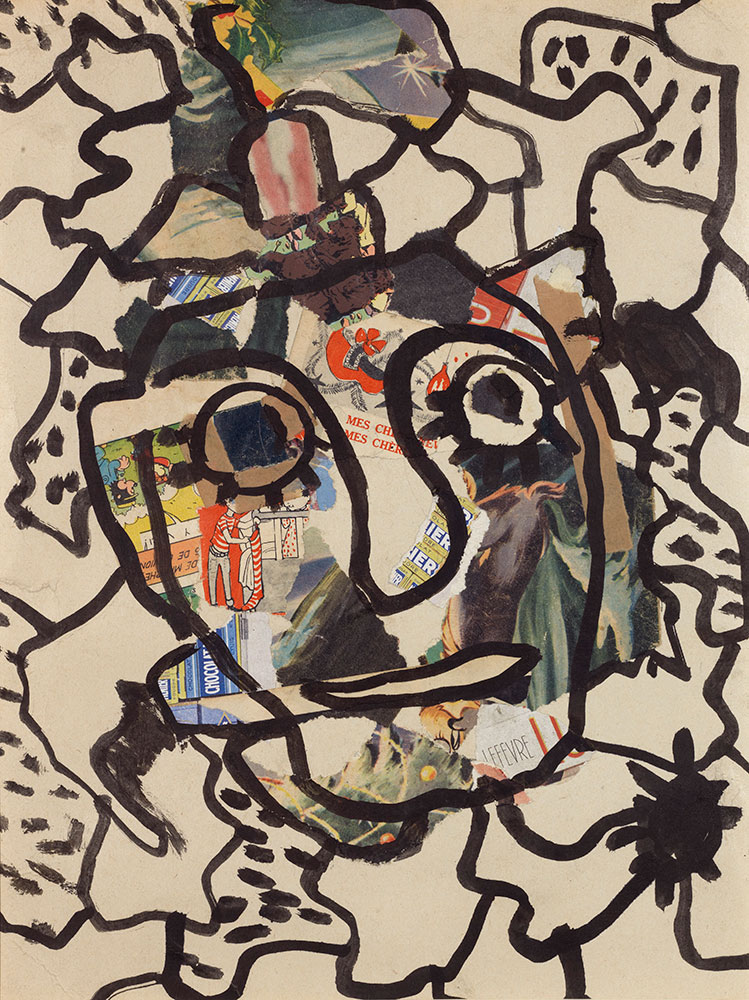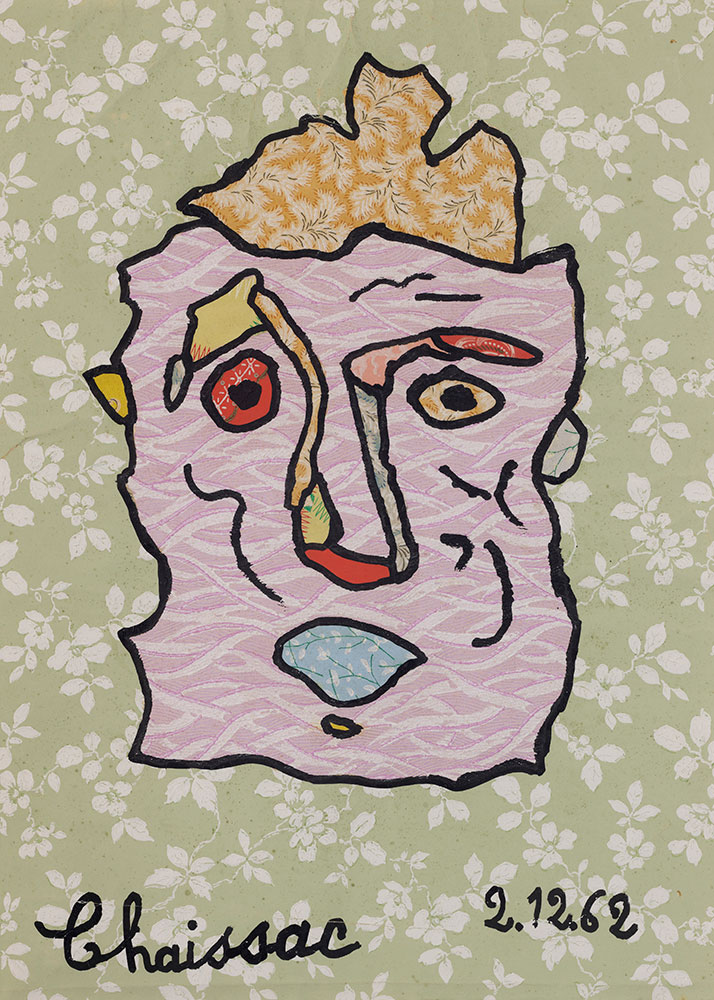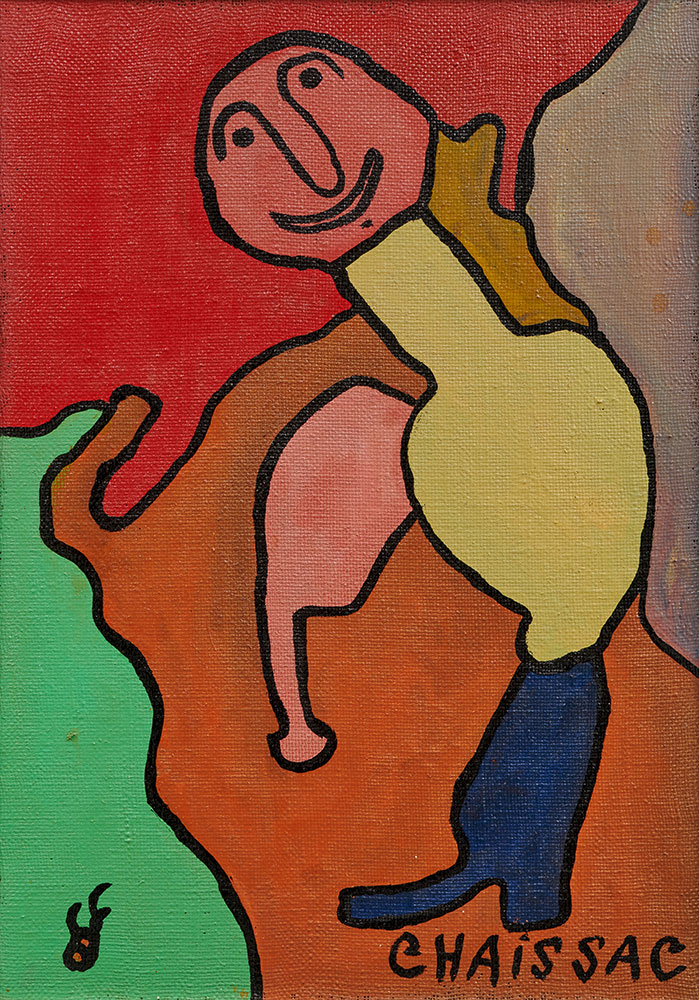ART-PRESENTATION: Gaston Chaissac-CoBrA and Chaissac
Born in 1919 in Avallon, France, Gaston Chaissac began to create art in his mid-twenties, a passion that was interrupted by World War II and poor health. He suffered from tuberculosis, and for a time, produced art while convalescing in a sanitorium. After the war, his poetry and prose appeared in French journals dedicated to proletarian writing. Chaissac’s artwork is both playful and powerfully raw. His drawings and paintings are populated by primitive, childlike figures constructed by a patchwork mode of wildly colored elements, defined and held together by restless, black contours.
By Efi Michalarou
Photo: Kunstmuseum Den Haag Archive
Gaston Chaissac extended this signature, visual collage mode to three dimensions in sculptures and assemblages made of found objects and materials: cans, brooms, branches, and rocks to name only a few. His process involved a continual renewal and recharging of the discarded and the quotidian, a transfer of creative energy he traced to Druidic ancestry. With the exhibition “CoBrA and Chaissac – Kindred”, Kunstmuseum Den Haag introduces Gaston Chaissac to the Netherlands, combining his work with that of CoBrA Group for the first time. Chaissac and CoBrA are shown in separate galleries (though with plenty of glimpses through to the other), mirroring the situation in real life, their works rarely having occupied the same space at that time. In 1961 Gaston Chaissac exhibited work at Iris Clert’s renowned Paris gallery. It was enthusiastically received by all. The CoBrA artists (no longer a group by then) were the most excited by the works on show. The entire exhibition sold out in no time. Unfortunately, Chaissac was unable to attend for health reasons, and he would never meet his admirers in person. But they had inspired each other for years by then, as Kunstmuseum Den Haag will demonstrate for the first time in its exhibition CoBrA and Chaissac – Kindred Spirits. Though he never joined any art movement, the similarity between his work and that of the CoBrA artists is obvious. This movement grew out of the post-war zeitgeist, as artists broke with older tradition in pursuit of a new modern art for all, in which spontaneity, authenticity and honesty were paramount. A shared interest in naïve art and folk art, and the use of motifs like snakes and totems, made them kindred spirits. They painted everything they could get their hands on. Things may have turned out completely differently if Gaston Chaissac had not met painter Otto Freundlich and his wife Jeanne Kosnick-Kloss in Paris, where he lived with his brother for a time, running a shoe repair business. Freundlich, already a well-known artist, recognised Chaissac’s talent and gave him some painting materials. Chaissac, who was trying to make a living for himself as a craftsman, blossomed as he finally dared to devote himself to his art. In 1938 the couple arranged his first exhibition at Galerie Gerbo in Paris. Chaissac’s work evolved during the 1950s and 60s, a period when a wide variety of movements existed in parallel. His work fulfilled the huge desire in the art world and among the public for unspoilt forms of expression after the Second World War. Chaissac’s art attracted a great deal of attention, particularly from other artists. As such, he became a true artists’ artist. He managed to combine the ludic with the tragic, was cheery, colorful and authentic, but at the same time also deeply melancholy, solitary and lonely. This is why he was regarded as such an important artist in a decade where French existentialism dominated philosophy. His work could not be pigeonholed into any movement, and the variety of media and techniques he used made him idiosyncratic and unique. In Paris, he visited museums and galleries, and got to know more about architecture. He would later recall: “What fascinated me most was depictions of nature painted in colors that do not occur in nature, and it was precisely those colours that made them so beautiful”. He was not interested in openings and salons, preferring to stay at a distance, following his wife Camille, a teacher whose work took the couple to remote. There, he was free to work on his “rustic modern painting”, as he described his work, and to develop his art as he saw fit. Despite his reclusive life in the countryside, Chaissac did maintain a lively correspondence with critics, journalists, writers, painters and magazine editors. This kept him informed of, and part of, the artistic debate. In 1946 he came to the attention of Jean Dubuffet, who saw him as a representative of his Art Brut concept. But Chaissac did not wish to be labelled, and he distanced himself from the designation. He also had indirect contact with the members of CoBrA via magazines and galleries in Paris, and there was a great mutual admiration between them.
Photo: Left: Gaston Chaissac, Regard Noir (Dark gaze), 1959/1960, Collage, Private collection, Switzerland. Right: Gaston Chaissac, Character with horse, 1959, Enamel on wrapping paper on canvas, 95.5 x 65 cm., private collection, courtesy of Nathan Fine Art (Zurich / Potsdam)
Info: Kunstmuseum Den Haag, Stadhouderslaan 41, Den Haag, Netherlands, Duration: 5/6-19/9/2021, Days & Hours: Tue-Sun 10:00-17:00, www.kunstmuseum.nl




